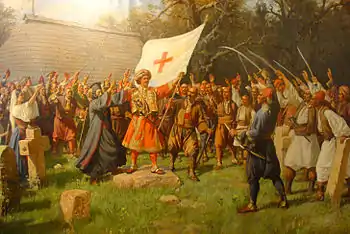The Serbian Revival (Serbian: Српски препород / Srpski preporod) or Serbian national awakening refers to a period in the history of the Serbs between the 18th century and the de jure establishment of the Principality of Serbia (1878). It began in Habsburg territory, in Sremski Karlovci.[1] The Serbian renaissance (Српска ренесанса / Srpska renesansa) is said to have begun in 17th-century Banat.[2] The Serbian Revival began earlier than the Bulgarian National Revival.[3] The first revolt in the Ottoman Empire to acquire a national character was the Serbian Revolution (1804–1817),[1] which was the culmination of the Serbian renaissance.[4] According to Jelena Milojković-Djurić: "The first literary and learned society among the Slavs was Matica srpska, founded by the leaders of Serbian revival in Pest in 1826."[5] Vojvodina became the cradle of the Serbian renaissance during the 19th century.[6] Vuk Stefanović Karadžić (1787–1864) was the most instrumental in this period.[7][8]
The Serbian Revival threatened to jeopardize Austria, to question its strategic interests.[9] The Serbs had established the short-lived Serbian Vojvodina during the 1848 Revolutions through armed conflict with the Hungarians, as part of the Revival.[10]
Although the Serbian Revival adopted the idea of cooperation between the Yugoslav peoples, and was influenced by its national policy basis and possibility of establishment of a Yugoslav state, it still, in a cultural and national-political view, stayed Pan-Serb.[11]
 Second Serbian Uprising (1815–17)
Second Serbian Uprising (1815–17) Proclamation of Serbian Vojvodina (1848)
Proclamation of Serbian Vojvodina (1848) Vuk Stefanović Karadžić (1787–1864)
Vuk Stefanović Karadžić (1787–1864)
See also
References
- 1 2 M. Şükrü Hanioğlu (8 March 2010). A Brief History of the Late Ottoman Empire. Princeton University Press. pp. 51–. ISBN 978-1-4008-2968-2.
- ↑ Francis Deák (1942). Hungary at the Paris Peace Conference: The Diplomatic History of the Treaty of Trianon. Columbia University Press. p. 370. ISBN 9780598626240.
- ↑ Viktor Novak (1980). Revue historique.
Иако је српски препород старији од бугар- ског, они су се надопуњивали. Књижевно „славеносрпски" и „сла- веноблгарски" су били блиски један другом, „нису се много разли- ковали и једнако су били доступни и за наше и за ...
- ↑ Fred Singleton (21 March 1985). A Short History of the Yugoslav Peoples. Cambridge University Press. pp. 72–. ISBN 978-0-521-27485-2.
- ↑ Jelena Milojković-Djurić (1994). Panslavism and national identity in Russia and in the Balkans, 1830-1880: images of the self and others. East European Monographs. p. 21. ISBN 9780880332910.
- ↑ Paul Robert Magocsi (2002). Historical Atlas of Central Europe. University of Toronto Press. pp. 34–. ISBN 978-0-8020-8486-6.
- ↑ Ingrid Merchiers (2007). Cultural Nationalism in the South Slav Habsburg Lands in the Early Nineteenth Century: The Scholarly Network of Jernej Kopitar (1780-1844). DCL Print & Sign. ISBN 978-3-87690-985-1.
The Serbian revival is especially linked with the name of Vuk Stefanovic Karadzic, who has been extensively studied and the subject of numerous monographs.
- ↑ Soviet Literature. Foreign Languages Publishing House. January 1956.
He helped Vuk Karadzich, prominent in the Serbian Renaissance, and one of the leading figures in the educational movement of his times,
- ↑ Petar Milosavljević (1995). Srpski nacionalni program i srpska književnost. Narodna i univ. knjižnica. p. 73. ISBN 9788679350091.
- ↑ Jugoslovenski istoriski časopis. Vol. 5. 1939. p. 242.
Српски препород. Ова глава почиње нашом борбом с Мађарима 1848/49. Она је била само један део велике европске револуције 1848 и вођена на наче- лима слободе народа и демократије, на којима је та рево- луција и почела.
- ↑ Vasa Čubrilović (1982). Istorij̀a političke misli u Srbij̀i XIX veka. Narodna kn̂iga. p. 160.